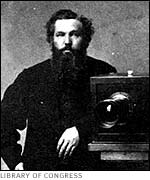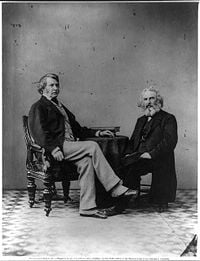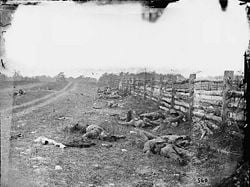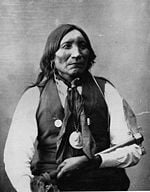Difference between revisions of "Alexander Gardner (photographer)" - New World Encyclopedia
David Doose (talk | contribs) m |
David Doose (talk | contribs) m |
||
| Line 1: | Line 1: | ||
| − | [[Image:Alexander Gardner.jpg| | + | [[Image:Alexander Gardner.jpg|thumb|250px|Alexander Gardner.]] |
'''Alexander Gardner''' (October 17, 1821 – December 10, 1882) was an [[United States|American]] [[photographer]]. He is best known for his photographs of the [[American Civil War]] and his [[portrait]]s of [[President of the United States|American President]] [[Abraham Lincoln]]. | '''Alexander Gardner''' (October 17, 1821 – December 10, 1882) was an [[United States|American]] [[photographer]]. He is best known for his photographs of the [[American Civil War]] and his [[portrait]]s of [[President of the United States|American President]] [[Abraham Lincoln]]. | ||
Revision as of 01:00, 14 October 2008
Alexander Gardner (October 17, 1821 – December 10, 1882) was an American photographer. He is best known for his photographs of the American Civil War and his portraits of American President Abraham Lincoln.
Mathew Brady's chief photographer during the early days of the Civil War, Gardner produced unforgettable pictures, among them Union troops in battle, Lincoln at Antietam, the ruins of Richmond, and Lee's surrender at Appomattox.
Gardner's classic also became foundational in the history of American photography, combining, for the first time, words and images in a sophisticated and moving account. These photos were published in Gardner's Photographic Sketch Book of the Civil War, a work which proved very influential in defining the image of the Civil War for many Americans.
Early years
Gardner was born in Paisley, Scotland, in 1821. He became an apprentice silversmith jeweler at the age of fourteen. Gardner had a Calvinist upbringing and was influenced by the work of Robert Owen, Welsh socialist and father of the cooperative movement. By adulthood he desired to create a cooperative in the United States that would incorporate socialist values. In 1850, Gardner and others purchased land near Monona, Iowa, for this purpose, but Gardner never lived there, choosing to return to Scotland to raise more money. He stayed there until 1856, becoming owner and editor of the Glasgow Sentinel in 1851. Visiting The Great Exhibition in 1851 in Hyde Park, London, he saw the photography of American Mathew Brady, and thus began his interest in the subject.
Gardner and his family moved to the United States in 1856. Finding that many friends and family members at the cooperative he had helped to form were dead or dying of tuberculosis, he stayed in New York. He initiated contact with Brady and came to work for him, eventually managing Brady's Washington, D.C., gallery.
The Civil War
Unfortunately, the most famous of Gardner's work has been proven to be a fake. In 1961, Frederic Ray of the Civil War Times magazine compared several of Gardner's photos showing "two" dead Confederate snipers and realized that the same body has been photographed in multiple locations. Apparently, Gardner was not satisfied with the subject matter as it was presented to him and dragged the body around to create his own version of reality. Ray's analysis was expanded on by the author William Frassanito in 1975.
Abraham Lincoln became an American President in the November, 1860 election, and along with his appointment came the threat of war. Gardner, being in Washington, was well-positioned for these events, and his popularity rose as a portrait photographer, capturing the visages of soldiers leaving for war.
Brady had had the idea to photograph the Civil War. Gardner's relationship with Allan Pinkerton (who was head of an intelligence operation that would become the Secret Service) was the key to communicating Brady's ideas to Lincoln. Pinkerton recommended Gardner for the position of chief photographer under the jurisdiction of the U.S. Topographical Engineers. Following that short appointment, Gardner became a staff photographer under General George B. McClellan, commander of the Army of the Potomac. At this point, Gardner's management of Brady's gallery ended. The honorary rank of captain was bestowed upon Gardner, and he photographed the Battle of Antietam in September 1862, developing photos in his traveling darkroom.
Gardner worked for the photographer Mathew Brady from 1856 to 1862. According to a New York Times review, Gardner has often had his work misattributed to Brady, and despite his considerable output, historians have tended to give Gardner less than full recognition for his documentation of the Civil War.[1]
Lincoln dismissed McClellan from command of the Army of the Potomac in November 1862, and Gardner’s role as chief army photographer diminished. About this time, Gardner ended his working relationship with Brady, probably in part because of Brady's practice of attributing his employees' work as "Photographed by Brady".[1] That winter, Gardner followed General Ambrose Burnside, photographing the Battle of Fredericksburg. Next, he followed General Joseph Hooker. In May 1863, Gardner and his brother James opened their own studio in Washington, D.C, hiring many of Brady's former staff. Gardner photographed the Battle of Gettysburg (July 1863) and the Siege of Petersburg (June 1864–April 1865) during this time.
He published a two-volume work: Gardner's Photographic Sketch Book of the Civil War in 1866. Each volume contained 50 hand-mounted original prints. Not all photographs were Gardner's; he credited the negative producer and the positive print printer. As the employer, Gardner owned the work produced, like any modern day studio. The sketchbook contained work by Timothy H. O'Sullivan, James F. Gibson, John Reekie, William R. Pywell, James Gardner (his brother), John Wood, George N. Barnard, David Knox and David Woodbury among others. A century later, photographic analysis suggested that Gardner had manipulated the setting of at least one of his Civil War photos by moving a soldier's corpse and weapon into more dramatic positions.[2]
Among his photographs of Abraham Lincoln were the last to be taken of the President, four days before his assassination. He also documented Lincoln's funeral, and photographed the conspirators involved (with John Wilkes Booth) in Lincoln's assassination. Gardner was the only photographer allowed at their execution by hanging, photographs of which would later be translated into woodcuts for publication in Harper's Weekly.
Post-War
Gardner was commissioned to photograph Native Americans who came to Washington to discuss treaties; and he surveyed the proposed route of the Kansas Pacific railroad to the Pacific Ocean. Many of his photos were stereoscopic. After 1871, Gardner gave up photography and helped to found an insurance company. Gardner stayed in Washington until his death. When asked about his work, he said, "It is designed to speak for itself. As mementos of the fearful struggle through which the country has just passed, it is confidently hoped that it will possess an enduring interest."[citation needed]
Legacy
Cornell Library's seven-millionth volume arrived by special art courier on December 19, 2002. The library’s seven-millionth volume, Gardner’s Photographic Sketch Book of the War, is the gift of Thomas A. Mann ’64 and Diann Goodman Mann ’66. The book is now housed in the Division of Rare and Manuscript Collections, where it enriches Cornell University Library’s collections chronicling American history. It enhances holdings of significant rare books, manuscripts, and photographs documenting the history of the abolitionist movement and the American Civil War.
Highlights from the library’s spectacular American historical materials, including Gardner’s Sketch Book, will be on view from June to September of 2003, as part of a major exhibition on the history of abolitionism from its origins in the eighteenth century through the Civil War. The exhibition will provide a rare opportunity to view some of the library’s greatest treasures, including a copy of the Gettysburg Address in Abraham Lincoln’s hand, a manuscript copy of the Emancipation Proclamation signed by Lincoln, and a presentation copy of the Thirteenth Amendment to the United States Constitution.[1]
The Alexander Gardner Lincoln Glass Plate Negative, the striking centerpiece of the IHS Lincoln Collections, is the original collodion wet-plate negative of the portrait of Abraham Lincoln made by Alexander Gardner. Lincoln sat for this photograph on 8 November 1863, just eleven days before delivering the Gettysburg Address. It is one of the best-known photographs of Lincoln and was used by sculptor Daniel Chester French as the model for the Lincoln Memorial in Washington, D.C. The collection includes a modern positive print of the image and the period envelope in which the glass plate negative was originally stored.[2]
Gallery
- Lincoln and McClernand.jpg
Lincoln and John Alexander McClernand, visiting the Antietam battlefield, 1862.
Notes
ReferencesISBN links support NWE through referral fees
- Johnson, Brooks, and Alexander Gardner. 1991. An enduring interest: the photographs of Alexander Gardner. Norfolk, Va: Chrysler Museum. ISBN 0940744635
- Gardner, Alexander. 1959. Gardner's photographic sketch book of the Civil War. New York: Dover Publications. ISBN 0486227316
- Katz, D. Mark, and Alexander Gardner. 1991. Witness to an era: the life and photographs of Alexander Gardner : the Civil War, Lincoln, and the West. New York, N.Y., U.S.A. ISBN 0670828203
- Lee, Anthony W., and Elizabeth Young. 2007. On Alexander Gardner's photographic sketch book of the Civil War. Defining moments in American photography, v. 1. Berkeley: University of California Press. ISBN 9780520251519
- "BIOGRAPHICAL SKETCH" in Collection #P 0420 of the Manuscript and Visual Collections Department, William Henry Smith Memorial Library, Indiana Historical Society. Retrieved August 4, 2006 from link.
External links
- An online version of Photographic Sketch Book of the Civil War. Retrieved June 19, 2008.
- Cornell University Library's online exhibition of its copy of Gardner's Photographic Sketch Book of the War. Retrieved June 19, 2008.
- A Eulogy on the Life and Character of Alexander Gardner at the Library of Congress. Retrieved June 19, 2008.
- Biography. Retrieved June 19, 2008.
- The photos whose scenes were altered. Retrieved June 19, 2008.
- Photojournalism: An Ethical Approach includes a passage on Gardner. Retrieved June 19, 2008.
- Museum-quality prints of Alexander Gardner photographs by Argent Editions. Retrieved June 19, 2008.
Credits
New World Encyclopedia writers and editors rewrote and completed the Wikipedia article in accordance with New World Encyclopedia standards. This article abides by terms of the Creative Commons CC-by-sa 3.0 License (CC-by-sa), which may be used and disseminated with proper attribution. Credit is due under the terms of this license that can reference both the New World Encyclopedia contributors and the selfless volunteer contributors of the Wikimedia Foundation. To cite this article click here for a list of acceptable citing formats.The history of earlier contributions by wikipedians is accessible to researchers here:
The history of this article since it was imported to New World Encyclopedia:
Note: Some restrictions may apply to use of individual images which are separately licensed.











